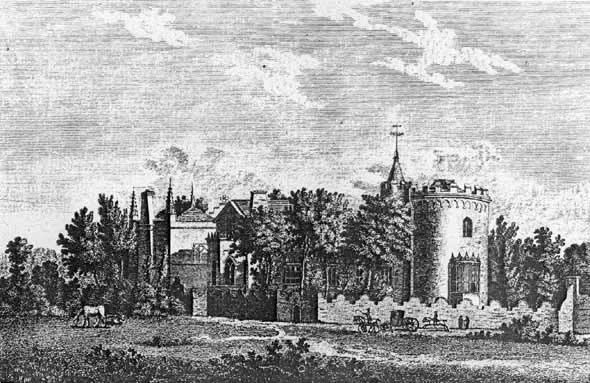
The appeal of Gothic architecture was so strong that it couldn't stay buried for long. The first major Gothic revival began in 1740's in England. Horace Walpole, the eccentric 4th Earl of Orford, was one of the first to re popularize the style. Walpole is one of those fascinating characters who makes the study of history worthwhile. I do so enjoy a good yarn, and Horace Walpole's life and work make for as good a story as I have ever read. Walpole was the son of Prime Minister Robert Walpole and the cousin of the famed Lord Nelson. Horace was an incurable romantic, given to dramatic and aesthetic indulgence--a bit of an 18th century Oscar Wilde (except with better breeding). Horace was quite taken with the Medieval period from an early age and decided to construct his own castle in homage to Gothic architecture. His most famous contributions to history were his neo-Gothic castle, Strawberry Field, the world's first Gothic novel, The Castle of Otranto, and the drama-laden Goth catch-phrase: "This world is a comedy to those that think, a tragedy to those that feel."
In 1747, Horace Walpole purchased a small villa near Twickenham. Together with a couple of friends, with whom he formed a "committee of taste," Walpole began working to transform the building into an estate, complete with an in-house printing press so that he could print his literary works! The resulting structure was christened Strawberry Hill. While Strawberry Hill is not an example of authentic Gothic architecture by any means, it helped inspire a movement to revive Gothic style.
Horace Walpole continued working on the house for the next 50 years. During that same time period he also wrote what is widely regarded as the first Gothic Novel, The Castle of Otranto, in 1764. He initially claimed that the novel had been discovered in the library of "an ancient Catholic family in the north of England." He also claimed that the original story dated back to the crusades. People didn't seem entirely convinced, so he eventually confessed that he had written it himself. His novel, in addition to his letters, are available here, courtesy of our friends at Project Gutenberg.
As we will see later, Horace Walpole's Gothic revival differed sharply from the revivals of the 19th century. Men like Pugin, Morris and Ruskin, admired Gothic style for its emphasis on natural beauty, whereas Walpole's revival is characterised by its extravagance and dedication to romance over nature. All of this raises an important question in my mind: both Morris and Walpole constructed anachronistic Gothic paradises for themselves (Morris at Red House and Walpole at Strawberry Hill). So was there any real difference between them? Leave a comment!
For more information on Strawberry Hill, visit Friends of Strawberry Hill, a site devoted to the preservation of Horace Walpole's project. They have some fabulous photos!
Further reading: I have gleaned some of the information in this post from a great article in Architectural History Vol. 38 (1995)entitled "Strawberry Hill: Building and Site" by Peter Guillery and Michael Snodin.
The 19th century woodcut of Strawberry Hill is courtesy of Wikimedia commons.
Friday, April 18, 2008
Horace Walpole, Strawberry Hill and Gothic Revival
Posted by
Margaret
at
9:52 AM
![]()
![]()
Labels: architecture, medieval
Subscribe to:
Post Comments (Atom)


4 comments:
The building itself is lovely, and I always like hearing about romantic characters in history, I've been reading about Ludwig II a lot lately, rich, eccentric men throughout history are fascinating.
It is interesting how eccentricity is romantically portrayed when it occured in the past. I personally could read about eccentrics all day. Daniel Johnston may be a good example of eccentricity being romanticized in the present.
I rarely think about Gothic art... I think that Classical (like ancient Greek and Roman) art and Modernism have a lot of aesthetic qualities in common, and the same with Baroque and Post-Modernist art. Gothic is trickier, the first thing I think of is the type face of the New York Times.
Good reading here, great blog.
another perfect reading..more edu-goth for me :)
I have just had the good fortune to visit the Houses of Parliament in London and admire the extraordinary work of Pugin. This was a timely visit to your blog because I was not familiar with the earlier phase of Gothic enthusiasm in the C18th. Thank you.
Post a Comment